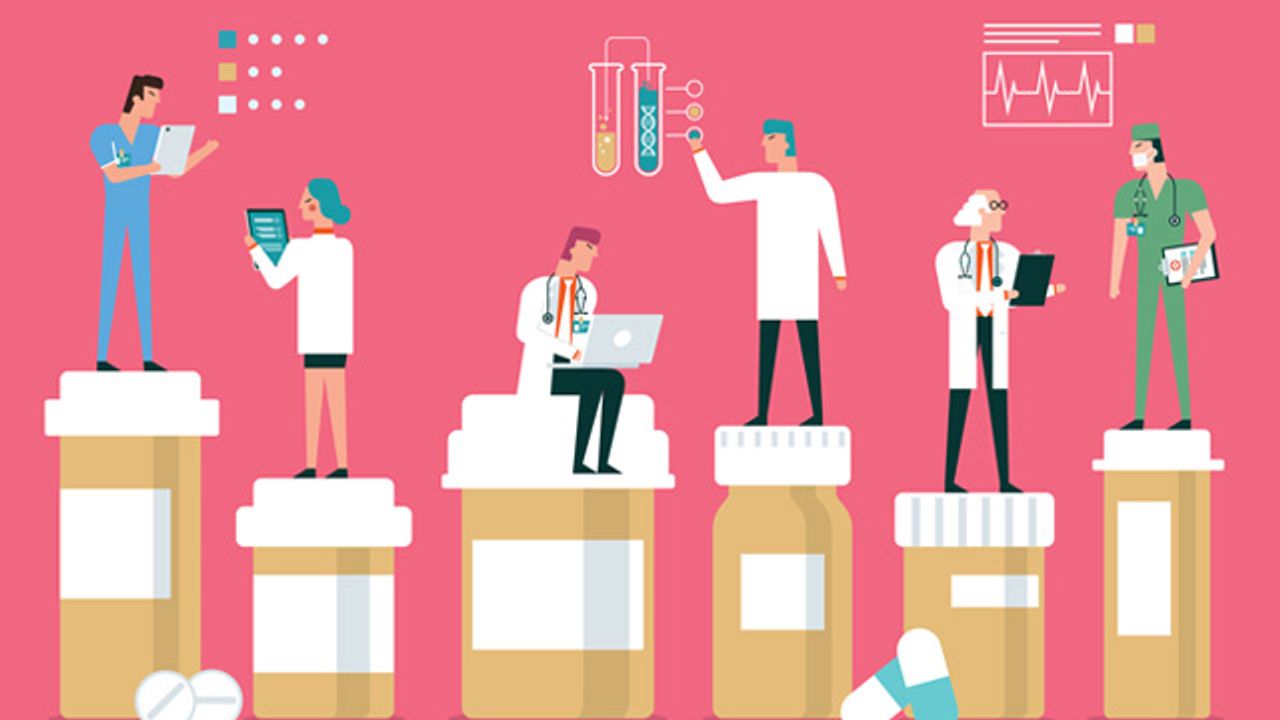
How Personalized Medicine Is Transforming Healthcare

How Personalized Medicine Is Transforming Healthcare
Complete the form below and we will email you a PDF version of"How Personalized Medicine Is Transforming Healthcare"
Over the last few decades, medical treatment programs have mostly been one-size fits all. Clinicians prescribe different medication or treatment options to patients based on that disease category. However, patients often respond differently to different treatments, so part of the process is working out the most effective treatment with the least severe side effects. Personalized medicine takes an entirely different approach. It aims to develop a precise clinical picture of a patient based on their unique biological makeup. This depth of information allows clinicians to identify variances in genes, RNA or proteins that could affect their susceptibility to a disease.
“By learning the unique disease characteristics specific to each patient or patient subgroup, personalized medicine aims to design smart and tailored drugs that are directly informed by these characteristics to treat disease in a more precise and targeted manner,” saysDr. Ashley Sanders,德国柏林的Max-Delbrück-CentrumFürMolekulareMedizin(MDC)的小组负责人。
While personalized medicine is a new approach in modern medicine, the idea of treating patients as individuals is hardly novel. As early as the second millennium BCE, ancient埃及ian medicine, followed later by Greek medicine, focused heavily on understanding an individual’s health, as well as their circumstances and beliefs. The one-size fits all approach arguably came into common usage with the rise of pharmaceutical companies in the early 20thcentury. Personalized medicine offers a return to these founding principles of treatment.
In this article, we discuss some of the advancements that are bringing personalized medicine into the fore.
Cracking the genetic code
TheHuman Genome Project也许是迈向个性化医学的最重要步骤之一。简而言之,它为医学的预防而不是纯粹的反应性铺平了道路。人类基因组的完整序列于2003年发表,使科学家和临床医生能够确定成千上万种疾病的遗传变异 - 一种称为基因组学的方法。它还为快速,便宜和准确的方式铺平了道路DNA and RNA sequencing, placing genomics at the core of research and treatment efforts for various human diseases.
Cancer is a great example of how genomics is used to为个别患者量身定制治疗based on genetic information. No two patient’s cancers are identical, and how a cancer develops is due to a complex relationship between基因与环境。DNA sequencing offers a way in, allowing clinicians to identify inherited genes that are known to increase an individual’s susceptibility to certain cancers.
After a diagnosis of cancer, DNA sequencing of tumor biopsies can identify genetic markers of cancer, allowing clinicians to direct certain anticancer treatments towards that specific abnormality (if the drug is available). For example, approximately seven percent of non-small cell lung cancers (NSCLCs) are caused by a heritable mutation in theALKgene encoding anaplastic lymphoma kinase (ALK). This discovery led to the development of ALK blockers such asceritinib, which can be selectively prescribed to patients withALK患有NSCLC的突变。
More recently, a new genomics approach calledsomatic mosaicismis taking personalized medicine one step further to adapt therapies to individual patient cells.
“Our group studies somatic mosaicism, which represents an exciting paradigm shift in how we understand the genetics of disease. We are usingsingle-cell technologiesto learn about the molecular changes and DNA mutations that form in our cells and how they change as we age and in disease. We aim to use this information to directly target the mutated cells that may participate or even drive the disease characteristics,” Sanders says.
非酒精性脂肪性肝炎的非侵入性监测

Nonalcoholic steatohepatitis (NASH) is an aggressive form of nonalcoholic fatty liver disease (NAFLD), a liver condition that is characterized by liver steatosis accompanied by liver cell injury and inflammation.Download this whitepaper to discover an assay that can identify biomarkers for susceptibility to NASH, reliably predict hepatic fat accumulation and help to predict the success of interventions in particular patient subpopulations.
查看白皮书
Sponsored Content
非酒精性脂肪性肝炎的非侵入性监测

Nonalcoholic steatohepatitis (NASH) is an aggressive form of nonalcoholic fatty liver disease (NAFLD), a liver condition that is characterized by liver steatosis accompanied by liver cell injury and inflammation.Download this whitepaper to discover an assay that can identify biomarkers for susceptibility to NASH, reliably predict hepatic fat accumulation and help to predict the success of interventions in particular patient subpopulations.
查看白皮书Sponsored Content
多组学的兴起
尽管基因组学是个性化医学的起点,但许多其他Omics技术的兴起正在扩大避免重复的潜力。蛋白质组学and transcriptomics are now used alongside genomics to understand abnormalities that can occur from the genetic code to RNA transcription, to protein synthesis and cellular function.
“These multiomic technologies are central to personalized medicine. It’s what allows us to deeply characterize patients and disease states so that targeted treatments can be developed,” Sanders notes.
Multiomic technologies are used to identify biomarkers of disease much likeALKmutations that occur in a subset of NSCLCs. Proteomics, for example, allows clinicians and scientists to understand all the molecular processes in a patient that drives a disease. Techniques such asmass spectrometry(MS)允许对具有非凡敏感性和轻松的患者的分子变化进行“高通量”鉴定和定量。
While older MS-based proteomics had issues with sensitivity and specificity, newer technologies (e.g.,liquid chromatography-MS)允许科学家从大量患者中生成有关数千种蛋白质的高度详细数据。确实,MS开始开发自己的临床领域,MS-based personalized drug therapy,但是由于与该方法相关的高成本,只有精选的实验室才能受益。因此,许多临床实验室继续使用较旧的低通量基于抗体的方法for clinical diagnostics until accessibility to MS-based methods are improved.
Big data, big potential
Creating a detailed, holistic view of individual patients requires tremendous computing power.Estimates vary,但是由于我们的基因组中有19,000至22,000个基因,我们的蛋白质组大致相同。理解这种影响如何影响人类疾病的复杂性是惊人的,甚至在您考虑替代剪接,单氨基酸多态性和post-translational modifications。
“This is big data which simply can’t be analyzed manually,” saysAnnalisa Occhipinti, associate professor at Teesside University, UK. “You need advanced computational techniques to find the source of a disease like cancer in all that data,” she adds.
Occhipinti,开发数据科学工具,用于与她的同事Claudio Angione一起使用,也是Teesside University的副教授。他们一直在使用数据科学来预测来自多组学数据的患者结果。
“我们从患者的临床概况开始,并将其与多组学数据以及扫描结果进行其他测试结果。我们使用机器学习将这些数据汇总在一起,该数据将数据从一名患者与大量患者的数据联系起来。这种交叉比较使我们能够预测癌症将如何进展以及哪些药物可以用来治疗该患者的特定癌症亚型。” Occhipinti说。
The rise of data science has been integral to personalized medicine: it is the node that integrates patient data and determines how to treat他们的疾病。像轻松访问DNA测序一样,随时可用的数据科学工具有助于将多解词整合到医疗保健系统中。但是,Occhipinti所描述的数据科学工具与临床使用相距甚远。
“一个重要的问题是计算预测的准确性。这比专家肿瘤学家更准确吗?这归结为培训算法。计算模型从中学到的数据越多,它们的预测准确性就越大。但是,也许问题是红鲱鱼,因为我们正在研究数据科学工具如何补充临床医生的决策而不是完全取代它。” Angione补充说。
治疗youandyourgenes
也许具有讽刺意味的是,数据科学使科学家不仅可以将患者视为一组数字。通过整合大量患者数据,临床医生和科学家在了解个人如何处理疾病方面具有很大的潜力。毕竟,每个患者都有不同的应对方式和应对疾病的反应。
Going back to the approaches used in ancient Egyptian medicine, personalized medicine must aim to incorporate psychological and environmental aspects of a patient’s life to treat diseases. Many scientists and clinicians are taking this on board, aiming to study subjective aspects of disease states with empirical techniques. For example, scientists have recently identified patterns of brain activity thatcorrespond to clinical pain。在仍在翻译工作的同时,最近发表的一项研究自然医学描述了一种算法的发展,该算法可以根据磁共振成像(fMRI)记录的大脑活动来检测单个患者的慢性疼痛态。有了这些数据,临床医生旨在评估患者是否正在遭受痛苦以及他们可以做些什么来治疗它。
When will personalized medicine reach the clinic?
自2000年代初期人类基因组发布以来,已经取得了巨大的进步来使医学更具个性化。多组学和数据科学技术的繁荣是有助于开发更好地针对个别患者的需求量身定制的医疗保健选择,而不是将它们适合于一种尺寸的方法。
但是,据桑德斯(Sanders)称,个性化医学在系统地整合到医疗保健系统中之前有一定的路要走:“生成深层表征患者所需的多瘤数据需要昂贵的技术,这些技术在诊所中不容易获得。从这些数据中提取疾病特征需要专门的知识和计算经验,这需要时间进行分析。当前的挑战是减少诊断的成本和时间,以便我们可以在常规临床实践中实施个性化医学。”
Perhaps what’s needed most to make personalized medicine accessible for more patients is not technological advancements, but methods to streamline personalized healthcare approaches into broader healthcare systems.





